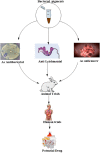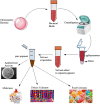Therapeutic applications of bacterial pigments: a review of current status and future opportunities
- PMID: 29623249
- PMCID: PMC5884752
- DOI: 10.1007/s13205-018-1227-x
Therapeutic applications of bacterial pigments: a review of current status and future opportunities
Abstract
Non-toxicity, biodegradability and non-carcinogenicity of the natural pigments, dyes and colorants make them an attractive source for human use. Bacterial pigments are colored metabolites secreted by bacteria under stress. The industrial uses of bacterial pigments have increased many folds because of several advantages over the synthetic pigments. Among natural resources, bacterial pigments are mostly preferred because of simple culturing and pigment extraction techniques, scaling up and being time economical. Generally, the bacterial pigments are safe for human use and therefore have a wide range of applications in pharmaceutical, textile, cosmetics and food industries. Therapeutic nature of the bacterial pigments is revealed because of their antimicrobial, anticancer, cytotoxic and remarkable antioxidant properties. Owing to the importance of bacterial pigments it was considered important to produce a comprehensive review of literature on the therapeutic and industrial potential of bacterial pigments. Extensive literature has been reviewed on the biomedical application of bacterial pigments while further opportunities and future challenges have been discussed.
Keywords: Antibacterial; Anticancer; Antileishmania; Antioxidant; Bacteria; Natural pigments.
Conflict of interest statement
Compliance with ethical standardsThe authors declare that there is no conflict of interest regarding the publication of this manuscript.
Figures
Similar articles
-
Multifaceted Applications of Microbial Pigments: Current Knowledge, Challenges and Future Directions for Public Health Implications.Microorganisms. 2019 Jun 28;7(7):186. doi: 10.3390/microorganisms7070186. Microorganisms. 2019. PMID: 31261756 Free PMC article. Review.
-
An Overview on Industrial and Medical Applications of Bio-Pigments Synthesized by Marine Bacteria.Microorganisms. 2020 Dec 22;9(1):11. doi: 10.3390/microorganisms9010011. Microorganisms. 2020. PMID: 33375136 Free PMC article. Review.
-
Fungi as a Potential Source of Pigments: Harnessing Filamentous Fungi.Front Chem. 2020 May 8;8:369. doi: 10.3389/fchem.2020.00369. eCollection 2020. Front Chem. 2020. PMID: 32457874 Free PMC article. Review.
-
A Review of the Chemistry and Biological Activities of Natural Colorants, Dyes, and Pigments: Challenges, and Opportunities for Food, Cosmetics, and Pharmaceutical Application.Chem Biodivers. 2023 Aug;20(8):e202300561. doi: 10.1002/cbdv.202300561. Epub 2023 Aug 7. Chem Biodivers. 2023. PMID: 37471105 Review.
-
Fungal Pigments: Potential Coloring Compounds for Wide Ranging Applications in Textile Dyeing.J Fungi (Basel). 2020 May 20;6(2):68. doi: 10.3390/jof6020068. J Fungi (Basel). 2020. PMID: 32443916 Free PMC article. Review.
Cited by
-
Production of bioactive β-carotene by the endophytic bacterium Citricoccus parietis AUCs with multiple in vitro biological potentials.Microb Cell Fact. 2023 May 3;22(1):90. doi: 10.1186/s12934-023-02108-z. Microb Cell Fact. 2023. PMID: 37138322 Free PMC article.
-
Evaluation of antioxidant potential of pigments extracted from Bacillus spp. and Halomonas spp. isolated from mangrove rhizosphere.BioTechnologia (Pozn). 2021 Jul 5;102(2):157-169. doi: 10.5114/bta.2021.106522. eCollection 2021. BioTechnologia (Pozn). 2021. PMID: 36606025 Free PMC article.
-
Multifaceted Applications of Microbial Pigments: Current Knowledge, Challenges and Future Directions for Public Health Implications.Microorganisms. 2019 Jun 28;7(7):186. doi: 10.3390/microorganisms7070186. Microorganisms. 2019. PMID: 31261756 Free PMC article. Review.
-
Carotenoid metabolism: New insights and synthetic approaches.Front Plant Sci. 2023 Jan 18;13:1072061. doi: 10.3389/fpls.2022.1072061. eCollection 2022. Front Plant Sci. 2023. PMID: 36743580 Free PMC article. Review.
-
Pseudomonas aeruginosa's greenish-blue pigment pyocyanin: its production and biological activities.Microb Cell Fact. 2023 Jun 8;22(1):110. doi: 10.1186/s12934-023-02122-1. Microb Cell Fact. 2023. PMID: 37291560 Free PMC article. Review.
References
-
- Aberoumand A. A review article on edible pigments properties and sources as natural biocolorants in foodstuff and food industry. World J Dairy Food Sci. 2011;6(1):71–78.
-
- Ahmad WA, Ahmad WYW, Zakaria ZA, Yusof NZ (2012) Application of bacterial pigments as colorant. In: Application of bacterial pigments as colorant. Springer, pp 57–74
-
- Arun N, Singh D. Differential response of Dunaliella salina and Dunaliella tertiolecta isolated from brines of Sambhar Salt Lake of Rajasthan (India) to salinities: a study on growth, pigment and glycerol synthesis. J Mar Biol Assoc India. 2013;55(1):65–70. doi: 10.6024/jmbai.2013.55.1.01758-11. - DOI
Publication types
LinkOut - more resources
Full Text Sources
Other Literature Sources





